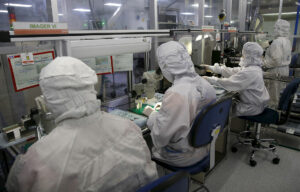FACTORY OUTPUT growth rose to its fastest pace in three months in July, the Philippine Statistics Authority (PSA) reported on Friday.
Preliminary results in the PSA’s latest Monthly Integrated Survey of Selected Industries (MISSI) showed factory output, as measured by the volume of production index (VoPI), quickened by 5.3% year on year in July, faster than the revised 3.6% growth in June and the 3.6% a year ago.
This was also the fastest growth in three months since the revised 7.5% growth in April.
On a month-on-month basis, the manufacturing sector’s VoPI rose by 4.7%, a turnaround from the 3.4% decline in June. Stripping out seasonality factors, output rose by 3.9% from the 1.3% drop a month earlier.
For the January to July period, VoPI growth averaged 2.1%, lower than 5.3% in the same period a year ago.
In comparison, the country’s manufacturing purchasing managers’ index (PMI) by S&P Global for that month stood at 51.2, easing from 51.3 in June.
A PMI reading below 50 marks a contraction in the manufacturing sector, while 50 marks an expansion.
Robert Dan J. Roces, chief economist at Security Bank Corp., said that the higher VoPI in July was due to a combination of better domestic demand and increased exports.
“The notable growth in computer, electronic, and optical products may be attributed to rising global demand for technology, particularly in areas like artificial intelligence and semiconductors,” Mr. Roces said in a Viber message.
For Ruben Carlo O. Asuncion, chief economist at Union Bank of the Philippines, the increase may have come from the improvement of trade within the region.
“Note that manufacturing production index remains to be in expansionary region in the covered months of June and July,” Mr. Asuncion said in a separate Viber message.
The PSA attributed the leap in July’s factory output growth to computer, electronic and optical products, which increased by 12.5% from 1.9% growth in June. The electronic and optical products account for second-largest weight (17.6%) of total manufacturing, after food products (18.7%).
Also contributing to the rise in July’s factory output growth were the production of transport equipment, which inched up by 0.4% from -8.1%, and food products (up by 14% from 11.4%).
The capacity utilization rate in July improved to 75.6%, from 73.6% last year and 75.3% last June.
All 22 industry divisions reported capacity utilization rates of above 60% percent in July.
Mr. Roces said that based on current indicators, positive performance in the manufacturing sector will continue in August and for the rest of the year.
“It (VoPI) will continue to improve, but at a slow pace as the market adjusts to the easing of restriction in the financial system (lower interest rate),” Mr. Asuncion said.
Last August, the Bangko Sentral ng Pilipinas (BSP) cut the interest rates by 25 basis points (bps) to 6.25% for the first time in nearly four years, which started of what BSP Governor Eli M. Remolona, Jr. called to as “calibrated” easing cycle amid an improving inflation and economic outlook.
However, prior to the cut, the central bank kept its policy rate at an over 17-year high of 6.5% for six straight meetings following cumulative hikes worth 450 bps between May 2022 and October 2023 to combat inflation.
The central bank signaled another 25-bp rate cut in the final three months of the year. — Charles Worren E. Laureta
